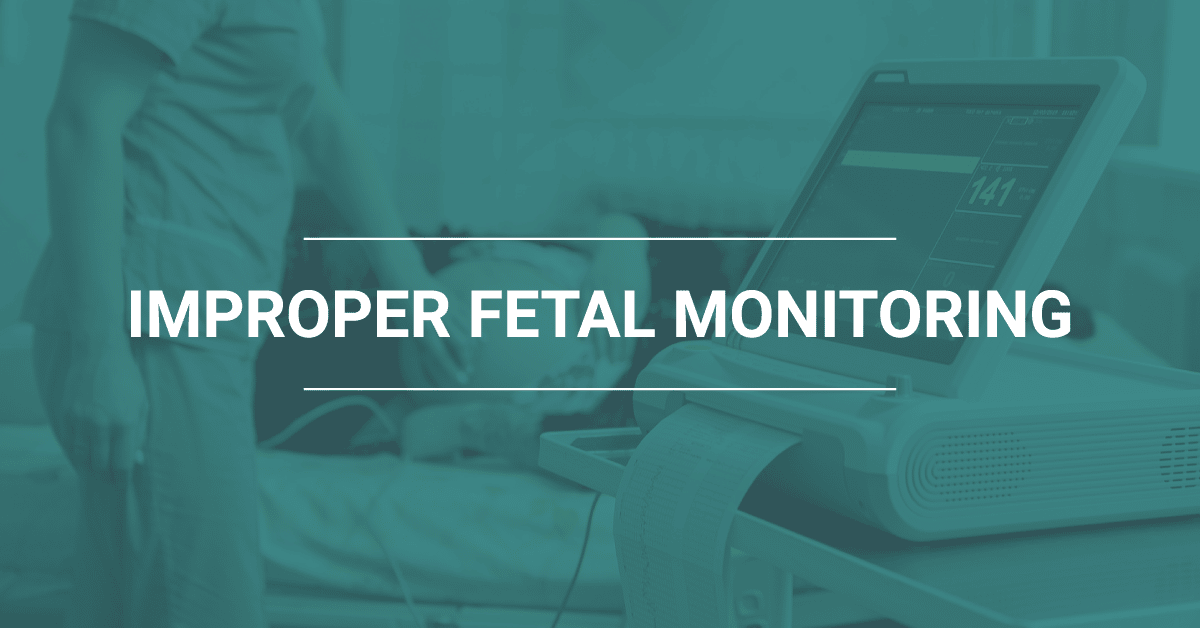During pregnancy as well as the labour and delivery process, it is critical to ensure that the baby is getting sufficient oxygen. This is done by monitoring the fetal heart rate (since fetal heart rate changes as oxygenation increases or decreases). An abnormal heart rate may indicate that the infant is in distress.
If a doctor or other medical professional notes signs of fetal distress, the labour may still continue, but requires more careful attention to ensure that the conditions causing the fetal distress do not continue or get worse. However certain patterns of fetal heart rate indicate that the fetus is in danger and are considered a medical emergency. Prompt intervention – such as through a cesarean section (c-section) – is often necessary to avoid the risk of a birth injury such as hypoxic-ischemic encephalopathy (HIE). Improper fetal monitoring and/or a failure to intervene appropriately may be evidence that the baby suffered an injury as a result of medical negligence.
How Is Fetal Heart Rate Monitoring Done?
There are three ways to monitor the fetal heart rate. The least reliable method is called auscultation, where the nurse or doctor listens to the fetal heart rate periodically using a special stethoscope or a doppler transducer.
The more reliable method is to use electronic fetal monitoring (EFM), where a belt-like device is strapped around the mother’s abdomen. This device then records the baby’s heart rate (known as fetal heart rate tracing) as well as the onset and end of contractions (known as the contraction pattern). EFM allows the obstetrical team to monitor the condition of the baby on a minute by minute basis.
The most reliable method of tracking fetal heart rate is by internal monitoring where an electrode is clipped to the baby’s scalp. However, internal monitoring can only be done once the fetal membranes have ruptured (water has broken). Internal fetal monitors offer the most accurate measurements of the baby’s heart rate.
However, while internal monitoring may be most accurate, there is a risk of complications with internal fetal monitoring. This may include infection, or bruising of your baby’s scalp (known as a fetal scalp electrode injury) or other body part. Also, some patients, such as those who are HIV+, might not be good candidates for internal fetal monitoring.
Why Monitor the Fetal Heart Rate?
A baby’s heart rate can tell doctors a lot about their health. During labour and delivery, the fetal heart rate is monitored to determine how the baby is tolerating the labour as a whole, but particularly how the baby is tolerating the contractions. There are certain patterns of fetal heart rates that are known to be reassuring, evidence that the fetus is well oxygenated.
Current guidelines consider a fetal heart rate of between 110 to 150 beats per minute (bpm) to 110 to 160 bpm to be within the normal range. Doctors and nurses can also gather additional information about fetal well being by looking at the pattern of the heart rate tracing and whether there are accelerations (spikes) or decelerations (dips) in the tracing.
On the other hand, there are fetal heart rate patterns that are known to be evidence that the fetus is not receiving enough oxygen. For example, a heart rate that is too slow (bradycardia) or a heart rate that is too fast (tachycardia) may be a sign of fetal distress. Specifically, bradycardia is usually a sign that the baby is not getting enough oxygen. In this situation, the baby should be delivered right away, usually via emergency c-section.
Tachycardia may indicate that the baby’s heart is working harder than normal to pump blood and oxygen to the body. Sustained tachycardia can lead to cardiovascular failure and other types of birth injuries. A high fetal heart rate may require medical treatment or early delivery.
Why Is Fetal Heart Monitoring Important?
Fetal heart rate monitoring is crucial to reduce the risk of many types of birth injuries, including HIE and cerebral palsy. It is one of the best indicators that something may be going on with the baby or mother that should be addressed.
Ultimately, this type of monitoring can help to detect changes in the normal heart rate pattern. Doctors, nurses, and other staff must closely review the data provided by fetal heart rate monitoring so that they can take steps to treat any underlying problem. At the same time, fetal heart rate monitoring can prevent treatments that may not be necessary. A normal fetal heart rate can also reassure both the patient and the physician that the baby is healthy and labour is progressing normally.
While an abnormal fetal heart rate pattern does not always mean that there is a problem with your baby, it is incredibly important that your obstetrician-gynecologist (ob-gyn) or other healthcare professional regularly review the fetal heart rate tracing to check for abnormalities. If they notice any instances of bradycardia or tachycardia, or lack of variability in the tracing, or repeated decelerations, then they can take steps to help the baby get more oxygen. This may be as simple as asking the mother to change position, administering oxygen or IV fluids to the mother, stimulating the fetal scalp, or reducing contraction frequency by decreasing or stopping medications such as Pitocin.
In some cases, an emergency c-section is the best and fastest way to intervene and reduce the risk of a birth injury such as cerebral palsy.
Signs and Symptoms of Fetal Distress
When it comes to fetal heart monitoring, there are several signs of potential fetal distress:
- A heart rate greater than 160 beats per minute (tachycardia) or a heart rate below 110 beats per minute (bradycardia) for an extended period of time;
- A decrease in heart rate variability (a flat or smooth tracing):
- An unusual frequency or severity of variable decelerations (drop in heart rate with contractions);
- Late decelrations (drop in heart rate after a contraction); and
- Slow returns to the baseline heart rate.
These are all considered “atypical” or “abnormal” readings and can be an indication that the baby might not be getting enough oxygen.
There are many different conditions that could cause these non-reassuring indications through fetal heart rate monitoring. They include:
- Uterine tachysystole (labor contractions that are too strong, go on for too long, or that are too frequent);
- Umbilical cord issues, such as umbilical cord compression, true knot umbilical cord, prolapse, or a nuchal cord (when the umbilical cord is wrapped around the baby’s neck);
- Placental abruption;
- Uterine rupture;
- Uteroplacental insufficiency;
- Polyhydramnios (excessive amniotic fluid);
- Oligohydramnios (insufficient amniotic fluid); and
- Problems with the birthing process, such as cephalopelvic disproportion (baby’s head is too large to fit through the birth canal), macrosomia (large baby), or breech position.
Fetal monitoring is the most important tool health care professionals can use to ensure that the baby has enough oxygen and to reduce the risk of complications due to lack of oxygen. If a doctor fails to meet the standard of care for fetal heart rate monitoring, it may be the basis of a medical negligence test.
Concerned about Improper Fetal Monitoring? The Birth Injury Lawyers Alliance Can Help.
There is a certain standard of care that medical professionals must meet when treating mothers and infants through pregnancy, labour, and delivery. If they fail to meet this standard, serious birth injuries may result. In particular, improper fetal monitoring may lead to a failure to intervene, causing HIE, cerebral palsy, and other birth injuries.
If you believe that your baby may have suffered a preventable birth injury, a birth injury lawyer can advise you of your legal options. For help with HIE cases or other type of birth injury claims, call BILA today at 1-800-300-BILA or fill out our online contact form to t schedule a free initial consultation with a lawyer in your province.
Related:
Effects of a Prolonged Labour on a Baby

John McKiggan, QC has represented clients in pediatric and adult injury claims that have resulted in multi-million dollar awards. In recognition of his accomplishments, John has been honoured by his peers, who elected him president of the Atlantic Provinces Trial Lawyers Association. He has also been named Queen’s Counsel, a designation recognizing exceptional professional merit. John has been selected for inclusion in the Best Lawyers in Canada in the field of personal injury law, he is listed in the Canadian Legal Lexpert Directory and has been named a local litigation star by Benchmark Litigation Canada.

